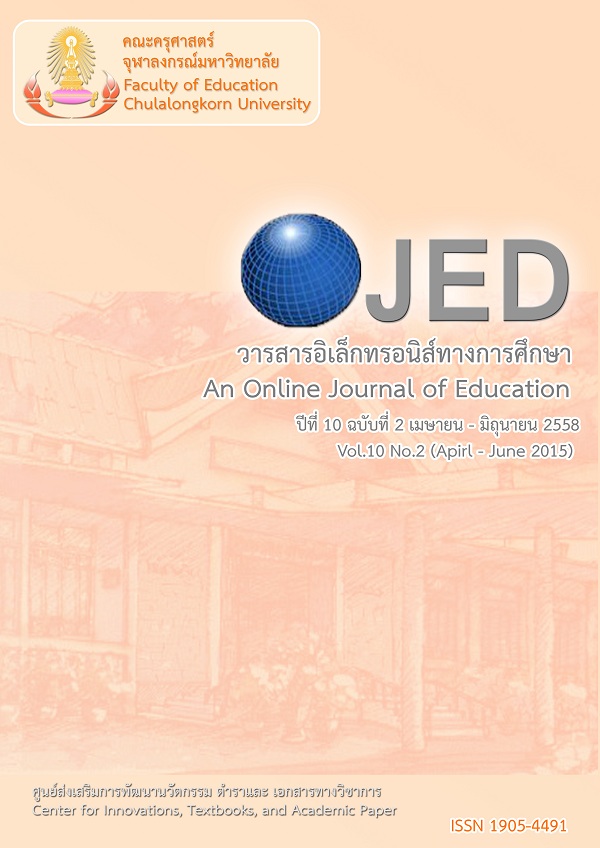ผลของการใช้รูปแบบการเรียนการสอน 5E ร่วมกับการใช้สัญศาสตร์ที่มีต่อความเข้าใจคำศัพท์ และผลสัมฤทธิ์ทางการเรียนชีววิทยาของนักเรียนมัธยมศึกษาตอนปลาย
Keywords:
รูปแบบการเรียนการสอน 5E, สัญศาสตร์, คำศัพท์ชีววิทยา, 5E INSTRUCTIONAL MODEL, SEMIOTICS, BIOLOGY TERMSAbstract
การวิจัยครั้งนี้เป็นการวิจัยกึ่งทดลองมีวัตถุประสงค์เพื่อ 1) ศึกษาความเข้าใจคำศัพท์ชีววิทยาของนักเรียนที่เรียนด้วยรูปแบบการเรียนการสอน 5E ร่วมกับการใช้สัญศาสตร์ 2) เปรียบเทียบความเข้าใจคำศัพท์ชีววิทยาระหว่างนักเรียนกลุ่มที่เรียนด้วยรูปแบบการเรียนการสอน 5E ร่วมกับการใช้สัญศาสตร์กับนักเรียนกลุ่มที่เรียนด้วยวิธีการสอนแบบทั่วไป3) ศึกษาผลสัมฤทธิ์ทางการเรียนชีววิทยาของนักเรียนหลังการเรียนโดยใช้รูปแบบการเรียนการสอน 5E ร่วมกับการใช้สัญศาสตร์ 4) เพื่อเปรียบเทียบผลสัมฤทธิ์ทางการเรียนชีววิทยาระหว่างนักเรียนมัธยมศึกษาตอนปลายกลุ่มที่เรียนด้วยรูปแบบการเรียนการสอน 5E ร่วมกับการใช้สัญศาสตร์กับนักเรียนกลุ่มที่เรียนด้วยวิธีการสอนแบบทั่วไป กลุ่มตัวอย่างคือ
นักเรียนระดับชั้นปีที่ 4 จังหวัดกรุงเทพมหานคร จำนวน 2 ห้องเรียน แบ่งเป็นกลุ่มทดลองซึ่งได้รับการจัดการเรียนการสอนโดยใช้รูปแบบการเรียนการสอน 5E ร่วมกับการใช้สัญศาสตร์ และกลุ่มควบคุมซึ่งได้รับการจัดการเรียนการสอนชีววิทยาแบบทั่วไป เครื่องมือที่ใช้ในการเก็บข้อมูลคือ แบบสอบความเข้าใจคำศัพท์ชีววิทยา และแบบสอบผลสัมฤทธิ์ทางการเรียนชีววิทยา วิเคราะห์ข้อมูลด้วยสถิติค่าเฉลี่ยเลขคณิต ส่วนเบี่ยงเบนมาตรฐาน และสถิติทดสอบทีหลังการทดลองสรุปได้ดังนี้ (1) นักเรียนกลุ่มทดลองมีคะแนนเฉลี่ยความเข้าใจคำศัพท์ชีววิทยา ร้อยละ 0 ซึ่งสูงกว่าเกณฑ์ที่กำหนดไว้ (2) นักเรียนกลุ่มทดลองมีคะแนนเฉลี่ยความเข้าใจคำศัพท์ชีววิทยาสูงกว่านักเรียนกลุ่มควบคุมอย่างมีนัยสำคัญทางสถิติที่ระดับ .05 (3) นักเรียนกลุ่มทดลองมีคะแนนเฉลี่ยผลสัมฤทธิ์ทางการเรียนชีววิทยา ร้อยละ 0 ซึ่งสูงกว่าเกณฑ์ที่กำหนดไว้ และ (4) นักเรียนกลุ่มทดลองมีคะแนนเฉลี่ยผลสัมฤทธิ์ทางการเรียนชีววิทยาสูงกว่านักเรียนกลุ่มควบคุมอย่างมีนัยสำคัญทางสถิติที่ระดับ .05
This study involved quasi-experimental research. The purposes of this study were: 1) to study the understanding of biology terms of students who learning through a 5E Instructional model with semiotics, 2) to compare the understanding of biology terms of students between an experimental
group that learning through the 5E Instructional model with semiotics and a control group that learning through a conventional instruction, 3) to study the leaning achievement in biology of students who learning through a 5E Instructional model with semiotics, 4) to compare the learning achievement in
biology of students between an experimental group and a control group. The samples comprised of two classes of Mathayom Suksa 4 students in Bangkok. The samples were divided into two groups: an experimental group and a control group. The research instruments were the understanding of biology
terms test and a learning achievement in biology test. Arithmetic means and standard deviations were used to analyze the collected data. The hypotheses were tested with t-test.
The research findings could be summarized as follows: (1) the mean score of the experimental
group in an understanding of biology terms was 0 percent which was higher than criterion score set. (2)
the mean score of the experimental group in an understanding of biology terms was higher than the
control group at a .05 level of significance. (3) the mean score of the experimental group in a learning
achievement in biology was 0 percent which was higher than criterion score set. (4) the mean score of
the experimental group in a learning achievement in biology was higher than the control group at a .05
level of significance.




